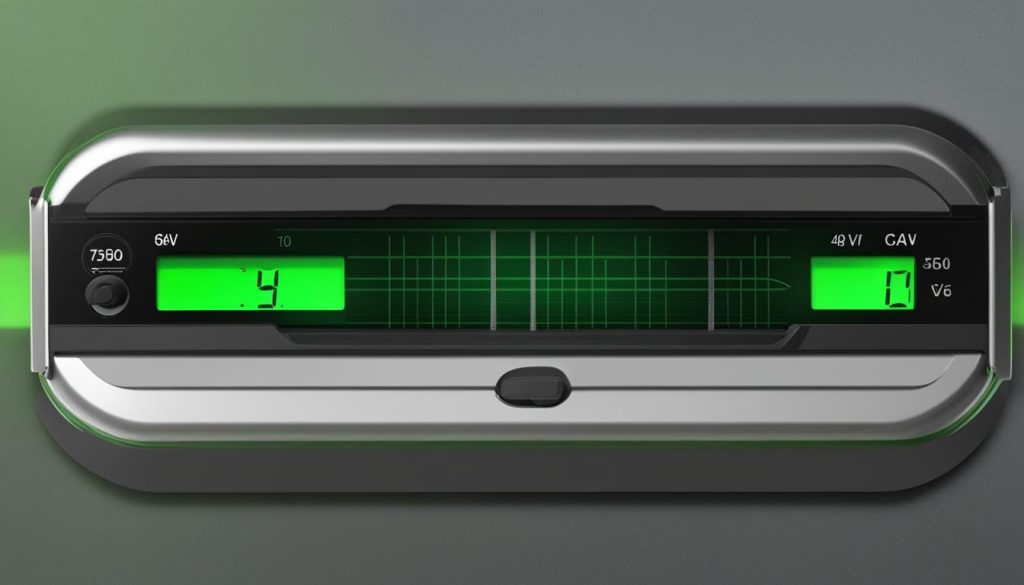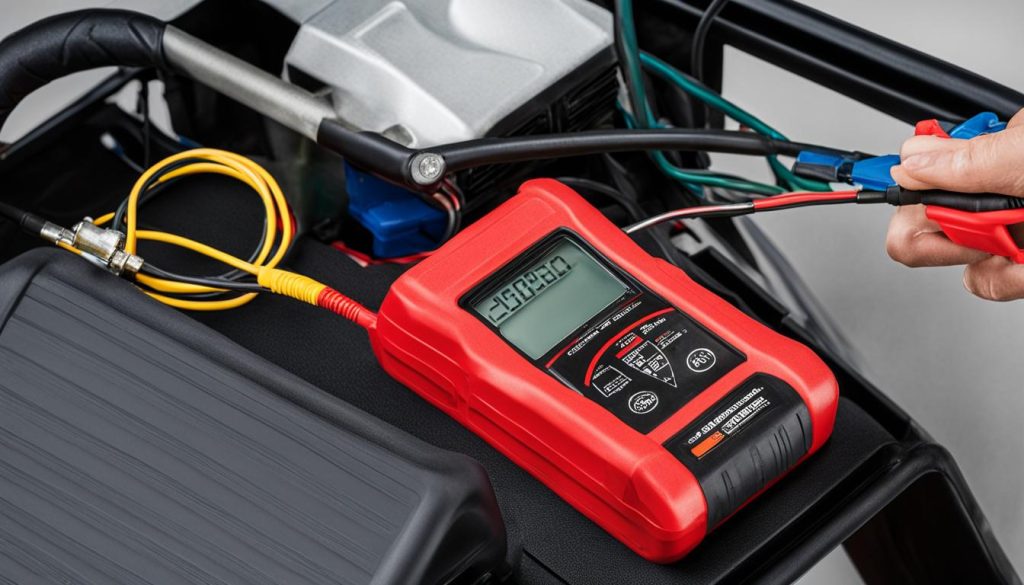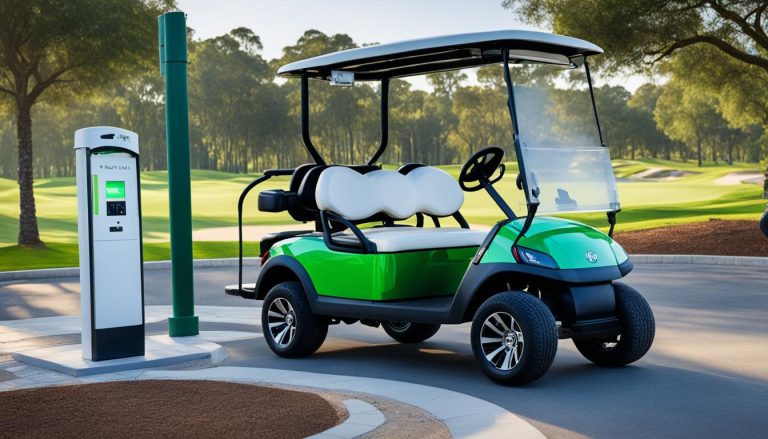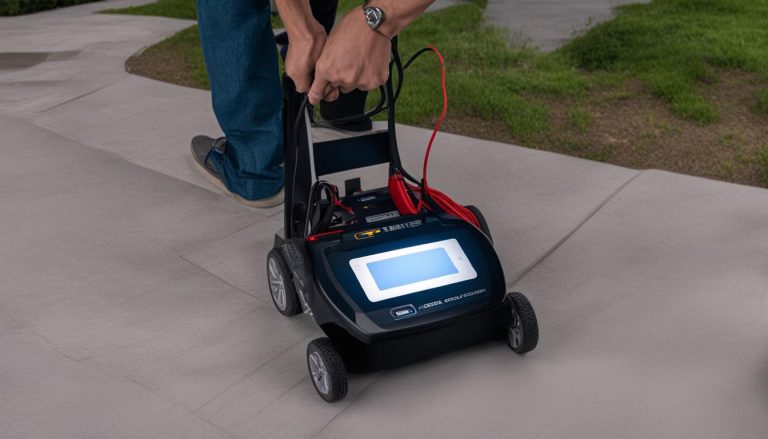Golf Cart Battery 101: Fully Charged Voltage Guide
batterychargers.site and its partners may earn a commission if you purchase a product through one of our links
Understanding the fully charged voltage of your golf cart battery is essential for optimizing its performance. By maintaining the correct voltage, you can ensure that your golf cart runs smoothly and efficiently, giving you the best golfing experience possible. In this guide, we will explore everything you need to know about fully charged golf cart battery voltage and how it impacts your battery’s performance.
Key Takeaways:
- Optimizing the voltage of your golf cart battery is crucial for its performance.
- Maintaining the correct voltage ensures smooth and efficient operation of your golf cart.
- Determining the voltage of your golf cart batteries is a simple calculation.
- Golf cart batteries power your cart by delivering the right amount of voltage and amperage.
- Proper maintenance practices can extend the lifespan of your golf cart batteries.
What You Need to Know About Golf Cart Batteries
When shopping for golf cart batteries, there are a few key considerations to keep in mind. Golf carts use multiple batteries that supply the necessary voltage and amperage. It is important to ensure that any replacement batteries you purchase match the combination of your current batteries. Additionally, golf cart batteries have different requirements and maintenance needs compared to car batteries, so it is crucial to choose the right type. Understanding the voltage and current of your golf cart batteries is essential for optimizing their performance and lifespan.
Golf Cart Battery Types
Before diving into the specifics of voltage and performance, let’s explore the different types of golf cart batteries available. The four main types are:
- Flooded Lead-Acid Batteries
- AGM Lead-Acid Batteries
- Gel Lead-Acid Batteries
- Lithium-Ion Golf Cart Batteries
Most golf carts come with flooded lead-acid batteries as the standard option. However, lithium-ion batteries have gained popularity in recent years due to their longer lifespan, maintenance-free nature, consistent power output, and faster recharge speeds. Each type has its own advantages and considerations, so it’s important to choose the one that best suits your needs and budget.
Optimizing Performance with the Right Voltage
Now, let’s focus on the importance of understanding and maintaining the correct voltage for your golf cart batteries. The voltage of a fully charged golf cart battery typically ranges from 36 to 48 volts, depending on the specific cart and battery configuration.
To ensure optimal performance and lifespan, it is crucial to maintain the fully charged battery voltage recommended by the manufacturer. This voltage level ensures that your golf cart operates at its full potential without overloading or underperforming.
When the battery voltage drops below a certain level, the performance of your golf cart may decrease. This can result in slower acceleration, reduced driving range, and overall diminished performance. On the other hand, excessively high voltage can lead to premature battery wear and other potential issues.
It’s essential to regularly check the battery voltage levels using a voltmeter or a dedicated battery monitoring system. This allows you to monitor the health of your batteries and take necessary actions such as recharging or replacing when needed.
Matching Battery Voltages
In multi-battery golf cart setups, it is crucial to ensure that all the batteries have a similar voltage level. Mismatched voltages can cause uneven power distribution, resulting in reduced performance and potential damage to the batteries.
When replacing batteries in your golf cart, always choose batteries with the same voltage as the existing ones. This ensures proper compatibility and optimal performance across all the batteries in the system.
Proper Maintenance for Extended Battery Life
Maintaining your golf cart batteries is essential for maximizing their lifespan and performance. Regularly check the battery voltage levels, clean the terminals, and ensure proper charging habits.
Refer to the manufacturer’s guidelines for specific maintenance recommendations for your battery type. While flooded lead-acid batteries may require periodic water level checks and occasional top-ups, lithium-ion batteries typically require little to no maintenance.
Avoid over-discharging your batteries, as this can significantly reduce their lifespan. Aim to keep the battery charge above 20% whenever possible to ensure optimal performance and longevity.
By understanding the voltage requirements, selecting the right batteries, and maintaining them properly, you can optimize the performance and lifespan of your golf cart batteries, allowing you to enjoy your golfing adventures to the fullest.
Determining the Voltage of Your Golf Cart Batteries
When it comes to optimizing the performance of your golf cart batteries, understanding their voltage is essential. Knowing the fully charged voltage of your golf cart batteries allows you to ensure that they are operating at their optimal levels, enabling your golf cart to perform at its best. To determine the voltage of your golf cart batteries, follow these simple steps:
- Count the number of acid holes on each battery:
- Multiply the number of acid holes by two:
- Multiply the voltage of each battery by the total number of batteries in your cart:
This is typically indicated by the number of caps on the battery. Each acid hole represents one volt.
This will give you the voltage of each individual battery.
By doing this, you can determine the overall voltage required to power your golf cart.
It’s important to note that altering the voltage of your golf cart batteries can cause damage and may void any warranties. Always adhere to the manufacturer’s recommendations and consult a professional if you’re unsure about the voltage requirements for your specific golf cart model.
Golf Cart Battery Voltage Calculation Example
| Battery | Acid Holes | Voltage |
|---|---|---|
| Battery 1 | 6 | 12V |
| Battery 2 | 6 | 12V |
| Battery 3 | 6 | 12V |
| Battery 4 | 6 | 12V |
| Total | – | 48V |
In the example above, each battery has six acid holes, resulting in a voltage of 12V per battery. Since there are four batteries in total, the overall voltage required to power the golf cart is 48V.
Understanding the voltage of your golf cart batteries is vital for maintaining their performance and ensuring that your golf cart operates smoothly. With the right voltage, you can enjoy optimal driving experiences on the course without any disruptions.
Understanding How Golf Cart Batteries Power Your Cart
Golf cart batteries play a vital role in providing the power necessary to operate your cart. To optimize performance and extend battery life, it’s important to understand how these batteries power your cart.
Voltage: Voltage represents the amount of power stored in the battery. It determines the force with which the electricity flows through the system. For golf cart batteries, the typical voltage range is 6 to 8 volts per battery, depending on the type. Maintaining the correct voltage is crucial for optimal performance.
Amperage: Amperage, also known as the battery’s current output, determines how fast the power is delivered. It measures the flow rate of the electricity. Golf cart batteries usually have different amperage ratings, and the amperage affects the batteries’ overall capacity and performance.
By understanding the relationship between golf cart battery voltage and amperage, owners can make informed decisions to maximize battery power and enhance the performance of their carts.

Optimizing Battery Power
Proper maintenance and care are key to ensuring your golf cart batteries operate at their full potential. Here are some tips to optimize battery power:
- Regularly inspect and clean the battery terminals to prevent corrosion and ensure good electrical connections.
- Check the water levels in your flooded lead-acid batteries regularly and replenish them as necessary, following the manufacturer’s guidelines.
- Keep the batteries charged at the recommended voltage range to avoid undercharging or overcharging, which can diminish battery performance and lifespan.
- Avoid deep discharging the batteries, as it can reduce their capacity and shorten their lifespan.
- Consider investing in a quality battery charger designed specifically for golf cart batteries to ensure proper charging and maintenance.
When it comes to battery power, a little care and attention can go a long way in optimizing your golf cart’s performance and extending the lifespan of the batteries.
Challenge yourself:
Create a table comparing the voltage and amperage ratings for different types of golf cart batteries. Include flooded lead-acid batteries, AGM lead-acid batteries, gel lead-acid batteries, and lithium-ion batteries. Provide a clear and concise summary of the key differences between these battery types. The table should be informative and visually appealing.
Maintaining Your Golf Cart Batteries
Proper maintenance is crucial for maintaining the lifespan of your golf cart batteries. By following these essential battery maintenance practices, you can ensure optimal performance and extend the lifespan of your golf cart batteries.
Cleaning and Preventing Corrosion
Regularly clean your golf cart batteries to remove any dirt, debris, or corrosion that may accumulate. Use a mixture of baking soda and water to create a cleaning solution, then use a soft brush to scrub the battery terminals and cables. Rinse with clean water and dry thoroughly. By preventing oxidation and acid contact with the terminals, you can help prolong the life of your batteries.
Inspecting and Replacing Frayed Cables
Regularly inspect the cables connecting your golf cart batteries for any signs of fraying or damage. Frayed cables can cause power loss and negatively impact the performance of your batteries. Replace any frayed cables immediately to maintain proper electrical connections and extend the lifespan of your batteries.
Charging Guidelines
Follow the recommended charging guidelines for your golf cart batteries. Charge your batteries between 8 to 10 hours and avoid deep charging. It is also important to keep the charge above 20% to prevent damage to the battery cells. Avoid jump-starting your batteries off your car, as this can lead to improper charging and potential damage.
| Battery Maintenance Tips |
|---|
| 1. Clean your golf cart batteries regularly to remove dirt, debris, and corrosion. |
| 2. Inspect and replace frayed cables to ensure proper electrical connections. |
| 3. Follow recommended charging guidelines to maintain battery health. |
By adhering to these maintenance practices, you can maximize the lifespan of your golf cart batteries and keep your cart running smoothly on the course for years to come.

Types of Golf Cart Batteries
When it comes to golf cart batteries, there are several types to choose from, each with its own unique characteristics and advantages. Understanding the different types of golf cart batteries can help you make an informed decision that best suits your needs and preferences. Let’s explore the four main types of golf cart batteries:
Flooded Lead-Acid Batteries
Flooded lead-acid batteries, also known as wet cell batteries, are the most common type of golf cart battery. They have been used for decades and are known for their reliability and affordability. These batteries require regular maintenance, such as checking fluid levels and adding distilled water when necessary. While flooded lead-acid batteries may require more attention, they are a popular choice due to their availability and cost-effectiveness.
AGM Lead-Acid Batteries
AGM lead-acid batteries, or Absorbent Glass Mat batteries, are a sealed maintenance-free type of battery. They are designed to be completely spill-proof and require no water maintenance. AGM batteries are known for their durability and are resistant to vibration and shock, making them an excellent choice for rough terrains. They also have a lower self-discharge rate compared to flooded batteries, allowing them to hold their charge for more extended periods.
Gel Lead-Acid Batteries
Gel lead-acid batteries utilize a gel electrolyte instead of a liquid or solid electrolyte. The gel electrolyte provides enhanced stability and prevents acid stratification, which can occur in other battery types. Gel batteries are also maintenance-free and highly resistant to vibration and shock. However, they are more expensive than flooded batteries and require a specific charging profile to ensure optimal performance and longevity.
Lithium-Ion Golf Cart Batteries
Lithium-ion golf cart batteries are the latest innovation in golf cart battery technology. They offer numerous advantages over traditional lead-acid batteries, including a longer lifespan, lighter weight, faster charging times, and consistent power output. Lithium-ion batteries are also maintenance-free and do not require water refills or specific charging profiles. While they may have a higher upfront cost, their extended lifespan and superior performance make them a cost-effective and sustainable option in the long run.
| Battery Type | Pros | Cons |
|---|---|---|
| Flooded Lead-Acid Batteries | Reliable and affordable | Require regular maintenance and water refills |
| AGM Lead-Acid Batteries | Sealed and maintenance-free | Higher initial cost |
| Gel Lead-Acid Batteries | Stable and resistant to vibration | More expensive and specific charging requirements |
| Lithium-Ion Batteries | Longer lifespan and faster charging | Higher upfront cost |
Choosing the right type of battery for your golf cart depends on factors such as your budget, maintenance preferences, and desired performance. Evaluate the advantages and disadvantages of each type to make an informed decision that will enhance the performance and longevity of your golf cart.
Average Lifespan of Golf Cart Batteries
When it comes to golf cart batteries, the average lifespan can vary depending on the type of battery you have. Lead-acid batteries, which are commonly used in golf carts, typically last between 6 to 10 years with proper maintenance. These batteries require regular checks, filling of distilled water, and proper charging to ensure longevity.
On the other hand, if you’re looking for a longer-lasting option, lithium-ion batteries are a great choice. These batteries can last up to 20 to 30 years with regular maintenance. They are known for their durability, high energy density, and low self-discharge rate. With lithium-ion batteries, you won’t have to worry about the frequent maintenance required by lead-acid batteries.
No matter what type of battery you choose, regular maintenance and proper care are key to extending the lifespan of your golf cart batteries. It’s important to keep your batteries clean, check for any signs of damage or corrosion, and follow the manufacturer’s guidelines for charging and storage.
Maintaining Lead-Acid Batteries:
- Check the battery terminals regularly for corrosion and clean if necessary.
- Ensure proper ventilation around the batteries.
- Check and refill distilled water as needed.
- Avoid overcharging or deep discharging the batteries.
Maintaining Lithium-Ion Batteries:
- Keep your batteries within their recommended temperature range.
- Avoid overcharging or completely draining the batteries.
- Regularly clean the battery terminals and connections.
- Store lithium-ion batteries in a cool, dry place when not in use.
By following these maintenance practices and choosing the right type of battery for your golf cart, you can maximize the lifespan of your batteries and ensure optimal performance on the green.
Choosing the Right Golf Cart Batteries
When it comes to selecting the ideal golf cart batteries for your needs, several factors should be taken into consideration. These include the battery type, lifespan, maintenance requirements, and cost. Two common types of golf cart batteries on the market today are lead-acid batteries and lithium-ion batteries.
Lead-acid batteries are generally more affordable upfront, making them a popular choice for many golf cart owners. However, they do require regular maintenance to ensure optimal performance and have a shorter lifespan compared to lithium-ion batteries.
On the other hand, lithium-ion batteries offer several advantages despite being more expensive initially. They provide longer lifespans, faster recharge speeds, and require no maintenance, making them incredibly convenient and hassle-free in the long run. While they may have a higher upfront cost, the benefits they offer can make them a worthwhile investment for golf cart enthusiasts.
Ultimately, the decision of which golf cart batteries to choose will depend on your specific requirements and budget. Carefully evaluate your needs and weigh the pros and cons of each battery type to make an informed decision. Whether you opt for lead-acid batteries or lithium-ion batteries, selecting the right batteries will ensure smooth and efficient performance for your golf cart.
FAQ
What is the fully charged voltage of a golf cart battery?
The fully charged voltage of a golf cart battery depends on the type of battery, but typically ranges from 36 to 48 volts for a standard 6-volt battery configuration.
How does the battery voltage impact the performance of a golf cart?
The battery voltage directly affects the power output of a golf cart. Maintaining the correct voltage is crucial for optimal performance and ensuring a longer battery life.
How can I determine the voltage of my golf cart battery?
To determine the voltage of your golf cart battery, count the number of acid holes on each battery and multiply it by two. Multiply this voltage by the total number of batteries in your cart to determine the overall voltage required.
How do golf cart batteries power the cart?
Golf cart batteries provide the necessary power to operate the cart. Voltage represents the amount of power, while amperage determines how fast the power is delivered.
How can I optimize the performance of my golf cart battery?
To optimize the performance and lifespan of your golf cart battery, it is important to regularly clean the batteries, prevent acid contact with terminals, inspect and replace frayed cables, and ensure proper charging and maintenance practices.
What are the different types of golf cart batteries?
There are four main types of golf cart batteries: flooded lead-acid batteries, AGM lead-acid batteries, gel lead-acid batteries, and lithium-ion golf cart batteries. Each type has its own characteristics and maintenance requirements.
How long do golf cart batteries typically last?
The average lifespan of golf cart batteries depends on the type of battery. Lead-acid batteries typically last between 6 to 10 years with proper maintenance, while lithium-ion batteries can last up to 20 to 30 years.
How do I choose the right golf cart batteries?
When choosing golf cart batteries, consider factors such as battery type, lifespan, maintenance requirements, and cost. Lead-acid batteries are generally more affordable but require regular maintenance, while lithium-ion batteries offer longer lifespans and require no maintenance.






